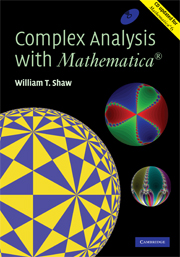Book contents
- Frontmatter
- Contents
- Preface
- 1 Why you need complex numbers
- 2 Complex algebra and geometry
- 3 Cubics, quartics and visualization of complex roots
- 4 Newton—Raphson iteration and complex fractals
- 5 A complex view of the real logistic map
- 6 The Mandelbrot set
- 7 Symmetric chaos in the complex plane
- 8 Complex functions
- 9 Sequences, series and power series
- 10 Complex differentiation
- 11 Paths and complex integration
- 12 Cauchy's theorem
- 13 Cauchy's integral formula and its remarkable consequences
- 14 Laurent series, zeroes, singularities and residues
- 15 Residue calculus: integration, summation and the argument principle
- 16 Conformal mapping I: simple mappings and Möbius transforms
- 17 Fourier transforms
- 18 Laplace transforms
- 19 Elementary applications to two-dimensional physics
- 20 Numerical transform techniques
- 21 Conformal mapping II: the Schwarz—Christoffel mapping
- 22 Tiling the Euclidean and hyperbolic planes
- 23 Physics in three and four dimensions I
- 24 Physics in three and four dimensions II
- Bibliograpy
- Index
24 - Physics in three and four dimensions II
Published online by Cambridge University Press: 05 August 2014
- Frontmatter
- Contents
- Preface
- 1 Why you need complex numbers
- 2 Complex algebra and geometry
- 3 Cubics, quartics and visualization of complex roots
- 4 Newton—Raphson iteration and complex fractals
- 5 A complex view of the real logistic map
- 6 The Mandelbrot set
- 7 Symmetric chaos in the complex plane
- 8 Complex functions
- 9 Sequences, series and power series
- 10 Complex differentiation
- 11 Paths and complex integration
- 12 Cauchy's theorem
- 13 Cauchy's integral formula and its remarkable consequences
- 14 Laurent series, zeroes, singularities and residues
- 15 Residue calculus: integration, summation and the argument principle
- 16 Conformal mapping I: simple mappings and Möbius transforms
- 17 Fourier transforms
- 18 Laplace transforms
- 19 Elementary applications to two-dimensional physics
- 20 Numerical transform techniques
- 21 Conformal mapping II: the Schwarz—Christoffel mapping
- 22 Tiling the Euclidean and hyperbolic planes
- 23 Physics in three and four dimensions I
- 24 Physics in three and four dimensions II
- Bibliograpy
- Index
Summary
Introduction
The goal of this Chapter is to provide you with a very basic understanding of how Laplace's equation (in three space variables) and the scalar wave equation (in three space and one time dimension) can be solved using holomorphic methods. This chapter will build on the methods developed in Chapter 23 in a very direct way, and you are recommended to read that chapter now before proceeding further here.
The material on dimension three is, in part, a much simplified version of part of a series of lectures given by Nigel Hitchin (now Professor, F.R.S.) in Oxford in the early 1980s. The picture presented here will not give you anything like the full geometrical picture underlying the results, which we shall develop by elementary methods. Part of the theory of the intrinsic three-dimensional approach is developed in a paper published by Hitchin (1982). The four-dimensional picture is covered most comprehensively by its principle architect, Professor Sir Roger Penrose, F.R.S., in Penrose and Rindler (1984a, b).
Laplace's equation in dimension three
Perhaps the most natural place to start is with the solution of Laplace's equation in three variables. In Chapter 23 we found, in Eq. (23.85), a natural holomorphic representation of a point in (possibly complex) three-dimensional space, arising as a degenerate case of a holomorphic null curve. This representation is in terms of a special type of quadratic holomorphic function.
- Type
- Chapter
- Information
- Complex Analysis with MATHEMATICA® , pp. 540 - 552Publisher: Cambridge University PressPrint publication year: 2006



